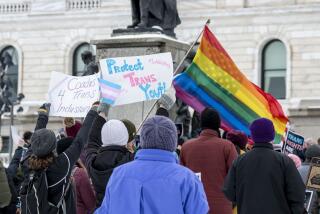Mixed-Race Generation Faces Identity Crisis
- Share via
Molefi Asante, chairman of the African-American Studies Department at Temple University, rejects the notion of pervasive color discrimination among blacks. Asante thinks that the black consciousness movement of the ‘60s and ‘70s dramatically reduced color bias in the African-American community.
The real problem, he suspects, is that there is a new “mulatto dilemma” brewing in America. Asante, 45, and the author of 24 books on black culture and history including “The Afro-Centric View,” says there is a whole new generation of mixed-raced children, born to black and white couples shortly before and after the U.S. Supreme Court struck down the nation’s anti-miscegenation laws in 1967.
‘Who Am I?’
These young people, some of them his students, have little knowledge of American history and the traditional definition of what it means to be black in America, “which is that any degree of African ancestry makes you black.” Even though that social definition still exists, says Asante, who is a black American, it is no longer rigidly enforced by law. “These students come to me and say: ‘I have one parent who is black and one who is white. Who am I?’ ”
Indeed, some social scientists believe that the growing numbers of mixed-raced children are an “emerging” population that will have a significant effect on American society--one that may lead to a new definition of race in America.
One such expert, UC Berkeley clinical psychologist Dr. Jewelle Taylor Gibbs, predicts that by the middle of the 21st Century “all current racial categories in America will become almost meaningless.”
Taylor Gibbs, who is an expert in the little-studied field of mixed-race children, says there are an estimated 1 million children of black-white marriages in the United States, based on the 1980 Census, “and that is probably an undercount.”
Interracial marriages will “continue to increase despite sentiment against them in the country,” says Taylor Gibbs, an associate professor in the School of Social Work at UC Berkeley and editor of “Young, Black and Male in America: An Endangered Species,” which will be released next month.
She is about to conduct a study of emotionally adjusted children from black-white families in the Oakland area, but cautions that her research so far has basically focused on children referred for psychological counseling.
Among this group, children frequently have a problem of “personal identity,” says Taylor Gibbs, who describes herself as black from a mixed-race background. “They find it difficult to call themselves black. The parents often bring them up with what I consider to be unrealistic attitudes. They tell them, ‘You are citizens of the world. You are God’s children.’
“And as I always say, ‘The census doesn’t have any place for God’s children.’ ”
Since there is no “colored” category, as exists in South Africa, or “mulatto” category in the United States, says Taylor Gibbs, these children don’t know what to label themselves.
‘Higher Prestige’
They tend to reject the black or minority part of their heritage, she says, because “in our society, whites have the higher prestige.”
But Linda Mahdesian, a guest on a recent “Donahue” show dealing with the issue of color bias in the black community, told viewers that it was time for a new category of race, not because she wanted to reject any part of her ancestry, but to affirm all of it.
“My father is black and American Indian, my mother is Irish, so I’m a blend of three different races,” she said. “I’m very proud of my black heritage. . . . I feel a bond with black people. I feel a bond with all of who I am . . . .”
From what Taylor Gibbs has observed of mixed-race children as a whole--not just those in a clinical setting--”this group is beginning to band together. They have national conferences now. They have a group called I-Pride, for Interracial Pride. And they have chapters in various cities and a newsletter.”
One such group, based in Los Angeles, has a bulletin called Spectrum, the Newsletter for Multi-Racial Americans of Southern California.
“By the year 2000, about one-third of our population will be non-white,” says Taylor Gibbs. “When that happens, we are going to have even more intermarriage among all different groups. By the middle of the 21st Century we are going to have what I call the ‘Browning of America’--a cafe au lait society. . . .”
By then, she forecasts, “nearly everybody will have somebody who has intermarried in their family. I think that’s going to reduce prejudice . . . among whites. Because if someone is your cousin’s husband and related to you, you’re going to have to begin to see people as individuals, and not in any stereotypical way.”
More to Read
Sign up for Essential California
The most important California stories and recommendations in your inbox every morning.
You may occasionally receive promotional content from the Los Angeles Times.













